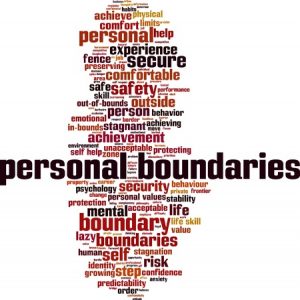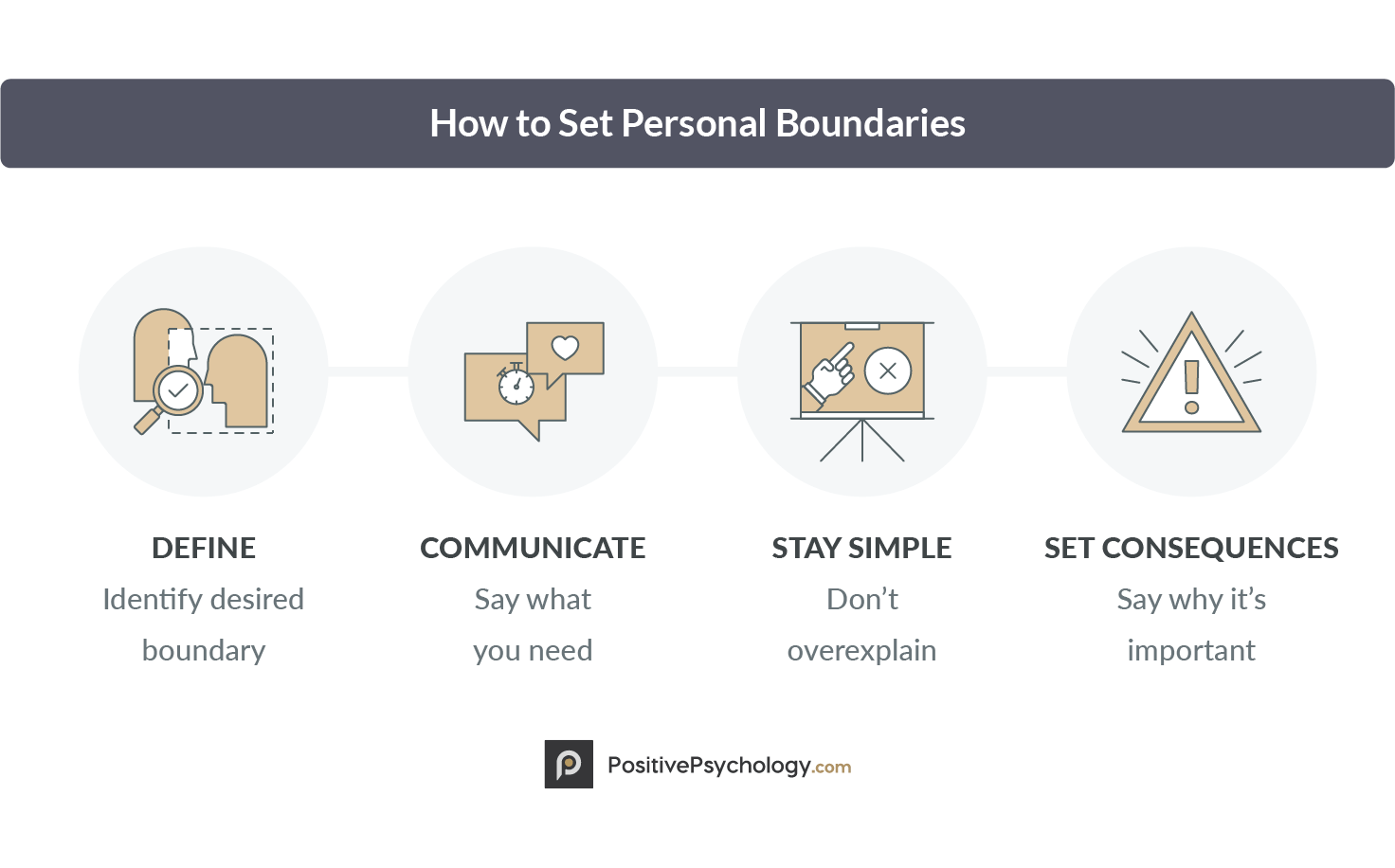Boundaries
Per Positive Phychology:
Expressing in very concrete measurable ways what we are willing to tolerate and what we aren’t. What we’re able to sustain and what we aren’t.
Setting boundaries is an important part of establishing one’s identity and is a crucial aspect of mental health and well-being.
Boundaries can be physical or emotional, and they can range from being loose to rigid, with healthy boundaries often falling somewhere in between.
One of the boundary signs is recognizing when my body is going into Fight or Flight and I need to stop. Making the plan ahead of time to tell your partner “Im feeling flooded and I need to stop.”
Learning to show compassion and kindness to yourself is crucial in setting healthy boundaries.
What Are Healthy Boundaries?
According to IPFW/Parkview Student Assistance Program:
“A boundary is a limit or space between you and the other person; a clear place where you begin and the other person ends . . . The purpose of setting a healthy boundary is, of course, to protect and take good care of you” (n.d.).
In general, “Healthy boundaries are those boundaries that are set to make sure mentally and emotionally you are stable” (Prism Health North Texas, n.d.). Another way to think about it is that “Our boundaries might be rigid, loose, somewhere in between, or even nonexistent. A complete lack of boundaries may indicate that we don’t have a strong identity or are enmeshed with someone else” (Cleantis, 2017).
Healthy boundaries can serve to establish one’s identity. Specifically, healthy boundaries can help people define their individuality and can help people indicate what they will and will not hold themselves responsible for.
While boundaries are often psychological or emotional, boundaries can also be physical. For example, declining physical contact from a coworker is setting an important boundary, one that’s just as crucial as setting an emotional boundary, i.e., asking that same coworker not to make unreasonable demands on your time or emotions.
Healthy Boundaries and Self-Care
 Healthy boundaries are a crucial component of self-care. That’s because “in work or in our personal relationships, poor boundaries lead to resentment, anger, and burnout” (Nelson, 2016).
Healthy boundaries are a crucial component of self-care. That’s because “in work or in our personal relationships, poor boundaries lead to resentment, anger, and burnout” (Nelson, 2016).
Some teachers say that setting boundaries helps them avoid burnout and stay in the profession longer (Bernstein-Yamashiro & Noam, 2013). This is important because it indicates that healthy boundaries at work help someone find more fulfillment and less stress in their professional life—leaving room for a better personal life.
More generally, the consequences of not setting healthy boundaries often include “stress, financial burdens, wasted time, and relationship issues, which can cause mental distress” (Prism Health North Texas, n.d.). In other words, a lack of healthy boundaries can negatively affect all aspects of someone’s life.
Setting healthy boundaries can have many benefits, including helping people make decisions based on what is best them, not just the people around them. This autonomy is an important part of self-care.
In the context of recovering from substance abuse, self-care can include “meaningful connection with recovery support and children, taking care of physical health, maintaining spirituality, healthy eating, exercise, journaling, continuing education, staying busy, sponsorship, establishing boundaries, self-monitoring, abstinence, and dealing with destructive emotions” (Raynor et al., 2017).
Self-care like this “may serve to support the general health and wellbeing of individuals” (Raynor et al., 2017).
Self-care, which can include setting boundaries, is an important part of leading a mentally healthy life. But unlike more intuitive aspects of self-care like healthy eating and exercise, setting healthy boundaries isn’t something most people understand. For more people to experience greater well-being and fulfillment, they must learn about healthy boundaries.
10 Examples Of Healthy Boundaries
 This leads to the question, ‘What do healthy boundaries look like?’
This leads to the question, ‘What do healthy boundaries look like?’
The types of boundaries one might set depends on the setting. That is, one person’s healthy boundaries with a romantic partner will be very different from that same person’s healthy boundaries with a boss or coworker.
To start out, we’ll look at professional boundaries.
In a teacher-student relationship, a teacher might set healthy boundaries by choosing to keep their personal lives separate from their professional lives by not telling their students too much about their private lives (Bernstein-Yamashiro & Noam, 2013).
Teachers can also begin each school year by telling students what they are and are not comfortable with. For example, teachers can tell their students they do not want to hear their students talking about illicit activities in the classroom.
Another way teachers can set boundaries is by telling themselves that they will not hold themselves responsible for every aspect of their students’ lives. That way, they won’t be too hard on themselves when a student suffers from something out of the teacher’s control.
Teachers are not the only professionals who can benefit from healthy boundaries. Mental health professionals also need to practice self-care and set healthy boundaries with their clients—they are not immune to stress and mental health disorders and might be even more vulnerable to those issues than the general population (Barnett et al., 2007).
One way that therapists can set clinical boundaries is by not connecting with their clients on social media (and being clear about this rule) so that they do not mix their professional responsibilities with their personal lives.
Of course, professionals are not the only ones who need to practice self-care by setting healthy boundaries. People can also set boundaries with their friends—even well-meaning ones.
For example, a woman in the middle of packing up her house for a move might not let a friend who dropped in unannounced stay too long—that way she can get done what she needs to get done (Katherine, 2000). Similarly, that woman might politely decline the same friend’s request to help her pack if she thinks packing should be a personal process (Katherine, 2000).
Healthy boundaries can help manage demands on people’s time, not just malicious or thoughtless demands on one’s time or emotions.
Another setting in which healthy boundaries are crucial is in a romantic partnership.
One example would be a person asking their partner for one night each week alone, as opposed to seeing each other daily. Another example would be a new mother asking her partner to take on more responsibility with their baby (such as giving baths, going to the park with the baby, and so on) so that she can have more time to herself (Barkin & Wisner, 2013).
Rather than fostering resentment, one can instead try to set and communicate their boundaries.
Finally, boundaries can be important in parent-child relationships. For example, parents might ask their child never to enter their bedroom without knocking first, in order to maintain some privacy. Children might ask their parents to never read their diaries or journals so that they can maintain some privacy of their own.
Parents can choose whether to respect a child’s proposed boundaries (they might reject some boundaries for safety reasons, for example), but it is important to be clear about the boundaries they do intend to respect in order to build trust with their children.
How To Set Personal and Emotional Boundaries

The first part of setting boundaries is examining the boundaries that already exist (or are lacking) in one’s life. For example, a woman might decide that she has healthy boundaries with her romantic partner, but not with her friends and coworkers. From there, she can decide what types of boundaries she wants to set with her friends and coworkers.
As for how to exactly set these boundaries, “Say ‘no’ simply but firmly to something you do not want to do. Do not feel that you need to explain” (Kairns, 1992). Not over-explaining is a crucial aspect of setting boundaries, as everyone has the right to determine what they do and do not want to do.
This brings up another important point: Keep the focus on yourself (IPFW/Parkview Student Assistance Program, n.d.). Instead of setting a boundary by saying something like, “You have to stop bothering me after work”, a person can say, “I need some time to myself when I get back from work.”
Another important thing to remember is: “It is impossible to set boundaries without setting consequences” (IPFW/Parkview Student Assistance Program, n.d.). This means that when setting boundaries, it is important to explicitly state why they are important.
For example, a person in an unhealthy relationship might declare that his partner needs to start respecting his career goals if his partner wants to continue being in a relationship with him. It is also crucial to only declare consequences that one is willing to follow through on, or else the boundaries will not be effective.
In general, the key to setting boundaries is first figuring out what you want from your various relationships, setting boundaries based on those desires, and then being clear with yourself and with other people about your boundaries.
Boundaries In Relationships
Boundaries in relationships can be especially important.
“When one person is in control of another, love cannot grow deeply and fully, as there is no freedom” (Cloud & Townsend, 2002).
In other words, healthy boundaries can be the difference between a healthy, happy relationship and a toxic, dysfunctional relationship.
A lack of boundaries can lead to an unhealthy relationship because one partner may feel that he or she has no privacy anymore (Hall Health Center Health Promotion Staff, 2014). However, too many boundaries can also be an issue, as in the case of people who refuse to spend time with the friends and families of their partners.
In the case of people in relationships who also have children, boundaries can be particularly important. For example, one research paper looking at self-care in new mothers highlighted a “willingness to delegate and the ability to set boundaries” as an important practical application of self-care (Barkin & Wisner, 2013).
A new mother who can set boundaries with her partner in order to respect her needs will likely be better off than one who cannot, and this will help the relationship too.
The fact that boundaries are important in relationships underscores the importance of setting and respecting boundaries. It’s important to understand and respect each other’s boundaries in a long-term partnership, just as it’s important to respect the boundaries of people whom one does not know very well.
One good way to avoid crossing someone’s boundaries (and to avoid having one’s own boundaries crossed) is to have honest conversations about boundaries with people.
Healthy Boundaries Worksheets (PDFs)
For people who want to learn more about boundaries, here are some worksheets that deal with healthy boundaries and how they can affect one’s life.
What are Personal Boundaries? Click on this worksheet:Boundaries
This worksheet explains the difference between rigid, porous, and healthy boundaries and the different areas in which one might set boundaries (such as physical boundaries, emotional boundaries, and sexual boundaries). After learning from this worksheet, you can explore your own boundaries with the supplementary exercise, also from Therapist Aid.
How to Create Healthy Boundaries.
Click on this worksheet: Creating Boundaries
This worksheet also describes different types of boundaries one might set and also offers tips for setting those boundaries.
Setting Healthy Personal Boundaries.
Click on this worksheet: Boundaries-Exploration-Activity
This worksheet is an excellent way to learn more about boundaries, determine if one needs to set more boundaries, and set those boundaries and stick to them.
Building Better Boundaries.
Click on this workbook: Workbook
This is less of a worksheet than it is an entire workbook (it’s more than 60 pages), but it can facilitate a deep dive into the topic of boundaries. It teaches the reader what boundaries are and how to set them in different situations.
Boundaries Worksheets for Kids and Parents (PDFs)
 Teaching children the importance of boundaries is a crucial part of parenthood. This can be hard, though, if parents themselves don’t understand the importance of boundaries.
Teaching children the importance of boundaries is a crucial part of parenthood. This can be hard, though, if parents themselves don’t understand the importance of boundaries.
Here are some worksheets and other resources that parents can use to teach their children (and themselves) about the importance of boundaries, both between children and their parents and between children and other people.
Boundaries. Click on this worksheet: Children+Boundaries
This worksheet will help children differentiate between rigid, clear, and fuzzy boundaries, and will also help them think about boundaries in their own lives.
Healthy Boundaries, Healthy Children.
Click on this worksheet: TeachingKidBoundaries
This worksheet is not for children, but rather for parents who want to teach their children about boundaries. It explains the importance of setting boundaries for children, then gives tips on how to teach them about boundaries. This is an excellent starting point for parents who are not sure how to set appropriate boundaries for their children.
Boundaries and Expectations Exercises
Livestrong.com provides helpful information on establishing boundaries that can be accessed here (Scottsdale, 2015). There are tips for parents of children of all ages, from toddlers to high schoolers. The article explains how using the word “no” can establish early boundaries for toddlers, and also explains the importance of extending trust to adolescents when they have earned it.
A Take-Home Message
Setting healthy boundaries is a crucial part of life and an important aspect of any self-care practice. Someone who’s not used to setting boundaries might feel guilty or selfish when they first start out, but setting boundaries is necessary for mental health and well-being. Appropriate boundaries can look very different depending on the setting, and it’s important to set them in all aspects of one’s life.
Finally, while setting boundaries is crucial, it is even more crucial to respect the boundaries that others have set for themselves. This goes for parents, children, romantic partners, bosses, coworkers, and anyone who interacts with or has power over anyone else. Respect is a two-way street, and appreciating the boundaries others have set for themselves is as important as setting boundaries for oneself.



